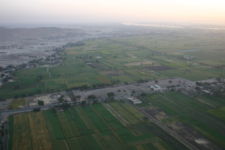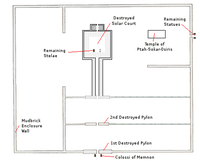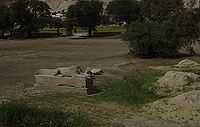
Mortuary Temple of Amenhotep III
Encyclopedia

Thebes, Egypt
Thebes is the Greek name for a city in Ancient Egypt located about 800 km south of the Mediterranean, on the east bank of the river Nile within the modern city of Luxor. The Theban Necropolis is situated nearby on the west bank of the Nile.-History:...
necropolis
Necropolis
A necropolis is a large cemetery or burial ground, usually including structural tombs. The word comes from the Greek νεκρόπολις - nekropolis, literally meaning "city of the dead"...
, on the west bank of the Nile
Nile
The Nile is a major north-flowing river in North Africa, generally regarded as the longest river in the world. It is long. It runs through the ten countries of Sudan, South Sudan, Burundi, Rwanda, Democratic Republic of the Congo, Tanzania, Kenya, Ethiopia, Uganda and Egypt.The Nile has two major...
, opposite Luxor
Luxor
Luxor is a city in Upper Egypt and the capital of Luxor Governorate. The population numbers 487,896 , with an area of approximately . As the site of the Ancient Egyptian city of Thebes, Luxor has frequently been characterized as the "world's greatest open air museum", as the ruins of the temple...
in Egypt
Egypt
Egypt , officially the Arab Republic of Egypt, Arabic: , is a country mainly in North Africa, with the Sinai Peninsula forming a land bridge in Southwest Asia. Egypt is thus a transcontinental country, and a major power in Africa, the Mediterranean Basin, the Middle East and the Muslim world...
. It was built for the Pharaoh
Pharaoh
Pharaoh is a title used in many modern discussions of the ancient Egyptian rulers of all periods. The title originates in the term "pr-aa" which means "great house" and describes the royal palace...
Amenhotep III
Amenhotep III
Amenhotep III also known as Amenhotep the Magnificent was the ninth pharaoh of the Eighteenth dynasty. According to different authors, he ruled Egypt from June 1386 to 1349 BC or June 1388 BC to December 1351 BC/1350 BC after his father Thutmose IV died...
. When constructed it was the largest of the mortuary temples in the Theban area, larger than the complex at Karnak
Karnak
The Karnak Temple Complex—usually called Karnak—comprises a vast mix of decayed temples, chapels, pylons, and other buildings, notably the Great Temple of Amun and a massive structure begun by Pharaoh Ramses II . Sacred Lake is part of the site as well. It is located near Luxor, some...
, and covered an area of 350,000 square metres.
Today very little remains of the complex, with only the Colossi of Memnon
Colossi of Memnon
The Colossi of Memnon are two massive stone statues of Pharaoh Amenhotep III. For the past 3400 years they have stood in the Theban necropolis, across the River Nile from the modern city of Luxor.-Description:The twin statues depict Amenhotep III The Colossi of Memnon (known to locals as...
– two massive 18-metre stone statues of Amenhotep that stood at the gateway, still visible. It was constructed closer to the river than any of the other mortuary temples, and hence decayed quicker, and it was used in ancient times as a source of construction material. A granite stele of Amenhotep can be found in the temple of Merenptah, which is located about 100 metres to the north.
The site has been included in the World Monuments Watch list of endangered sites by the World Monuments Fund
World Monuments Fund
World Monuments Fund is a private, international, non-profit organization dedicated to the preservation of historic architecture and cultural heritage sites around the world through fieldwork, advocacy, grantmaking, education, and training....
(WMF) in 1998 and 2004, and has received funding from the organization and from American Express
American Express
American Express Company or AmEx, is an American multinational financial services corporation headquartered in Three World Financial Center, Manhattan, New York City, New York, United States. Founded in 1850, it is one of the 30 components of the Dow Jones Industrial Average. The company is best...
.
Temple layout


Pylon (architecture)
Pylon is the Greek term for a monumental gateway of an Egyptian temple It consists of two tapering towers, each surmounted by a cornice, joined by a less elevated section which enclosed the entrance between them. The entrance was generally about half the height of the towers...
s then led to the solar court. These open courts have further seated statues of Amenhotep III, at least on sphinx
Sphinx
A sphinx is a mythical creature with a lion's body and a human head or a cat head.The sphinx, in Greek tradition, has the haunches of a lion, the wings of a great bird, and the face of a woman. She is mythicised as treacherous and merciless...
statue of Queen Tiye
Tiye
Tiye was the daughter of Yuya and Tjuyu . She became the Great Royal Wife of the Egyptian pharaoh Amenhotep III....
(which is now headless), jackal statues and Osirid
Osiris
Osiris is an Egyptian god, usually identified as the god of the afterlife, the underworld and the dead. He is classically depicted as a green-skinned man with a pharaoh's beard, partially mummy-wrapped at the legs, wearing a distinctive crown with two large ostrich feathers at either side, and...
statues of the king. Another sphinx with the body of a crocodile (again headless) has been found – this can still be seen today from the road that runs by the temple.
Solar court
A procession of sphinxes continues from the third pylon towards the solar court. This was surrounded by sandstone papyrus columns and further Osirid statues of Amenhotep III. These statues had lists of captives from foreign lands. At the south side of the entrance to the solar court a massive stela was found and has been re-erected, this shows the king with Queen Tiye and the god PtahPtah
In Ancient Egyptian Religion, Ptah was the deification of the primordial mound in the Ennead cosmogony, which was more literally referred to as Ta-tenen , meaning risen land, or as Tanen, meaning submerged land, though Tatenen was a god in his...
–Sokar–Osiris
Osiris
Osiris is an Egyptian god, usually identified as the god of the afterlife, the underworld and the dead. He is classically depicted as a green-skinned man with a pharaoh's beard, partially mummy-wrapped at the legs, wearing a distinctive crown with two large ostrich feathers at either side, and...
, with further texts describing the building accomplishments of the king.
See also
- Colossal quartzite statue of Amenhotep IIIColossal quartzite statue of Amenhotep IIIThe 18th Dynasty Ancient Egyptian colossal quartzite statue of Amenhotep III, dating from c.1350 BC, was found in the massive mortuary temple of the pharaoh Amenhotep III on the West Bank of the River Nile at Thebes in Egypt. Only the head of the broken colossal statue survives...
Found at the Mortuary Temple - Medinet HabuMedinet Habu (temple)Medinet Habu is the name commonly given to the Mortuary Temple of Ramesses III, an important New Kingdom period structure in the location of the same name on the West Bank of Luxor in Egypt...
(Mortuary Temple of Ramesses III) - Colossi of MemnonColossi of MemnonThe Colossi of Memnon are two massive stone statues of Pharaoh Amenhotep III. For the past 3400 years they have stood in the Theban necropolis, across the River Nile from the modern city of Luxor.-Description:The twin statues depict Amenhotep III The Colossi of Memnon (known to locals as...
, two massive statues built nearby

